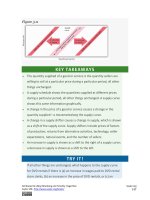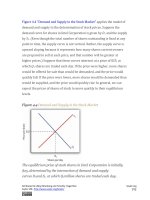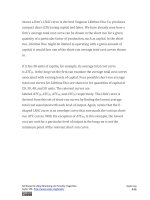Authors libby rittenberg 404
Bạn đang xem bản rút gọn của tài liệu. Xem và tải ngay bản đầy đủ của tài liệu tại đây (321.44 KB, 1 trang )
2. If two commodities that you purchase on a regular basis carry the
same price, does that mean they both provide the same total utility?
Marginal utility?
3. If a person goes to the bowling alley planning to spend $15 but comes
away with $5, what, if anything, can you conclude about the marginal
utility of the alternatives (for example, bowl another line, have a soda
or a sandwich) available to the person at the time he or she leaves?
4. Which do you like more—going to the movies or watching rented
DVDs at home? If you engage in both activities during the same
period, say a week, explain why.
5. Do you tend to eat more at a fixed-price buffet or when ordering from
an a la carte menu? Explain, using the marginal decision rule that
guides your behavior.
6. Suppose there is a bill to increase the tax on cigarettes by $1 per pack
coupled with an income tax cut of $500. Suppose a person smokes an
average of 500 packs of cigarettes per year—and would thus face a
tax increase of about $500 per year from the cigarette tax at the
person’s current level of consumption. The income tax measure would
increase the person’s after-tax income by $500. Would the combined
measures be likely to have any effect on the person’s consumption of
cigarettes? Why or why not?
7. How does an increase in income affect a consumer’s budget line? His
or her total utility?
8. Why can Ms. Bain not consume at point Y in Figure 7.13 "The UtilityMaximizing Solution"?
9. Suppose Ms. Bain is now consuming at point V in Figure 7.13 "The
Utility-Maximizing Solution". Use the marginal decision rule to explain
why a shift to X would increase her utility.
Attributed to Libby Rittenberg and Timothy Tregarthen
Saylor URL: />
Saylor.org
404









